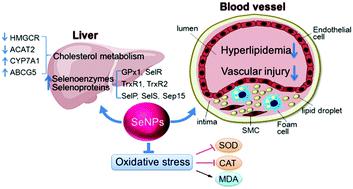当前位置:
X-MOL 学术
›
Metallomics
›
论文详情
Our official English website, www.x-mol.net, welcomes your
feedback! (Note: you will need to create a separate account there.)
Selenium nanoparticles alleviate hyperlipidemia and vascular injury in ApoE-deficient mice by regulating cholesterol metabolism and reducing oxidative stress.
Metallomics ( IF 2.9 ) Pub Date : 2019-11-22 , DOI: 10.1039/c9mt00215d Leilei Guo 1 , Junying Xiao , Haijuan Liu , Hongmei Liu
Metallomics ( IF 2.9 ) Pub Date : 2019-11-22 , DOI: 10.1039/c9mt00215d Leilei Guo 1 , Junying Xiao , Haijuan Liu , Hongmei Liu
Affiliation

|
Atherosclerosis and related cardiovascular diseases represent the greatest threats to human health worldwide. This study was designed to investigate the anti-atherosclerotic activity of selenium nanoparticles (SeNPs) in apolipoprotein E deficient (ApoE−/−) mice fed a high-cholesterol, high-fat diet. The results demonstrated that animals either treated with SeNPs (50 μg Se per kg per day) or with atorvastatin (10 mg per kg per day) alone showed significant relief of vascular injury after 8 weeks of treatment. SeNPs could obviously decrease the level of serum total cholesterol, triglyceride and low-density lipoprotein cholesterol, whereas increase serum high-density lipoprotein cholesterol. At the same time, SeNPs regulated the expression levels of key genes associated with cholesterol metabolism in the liver. Furthermore, SeNPs significantly reduced the lipid peroxidation level, but increased the NO level and the activities of glutathione peroxidase (GPx), superoxide dismutase (SOD) and catalase in the serum and liver. SeNPs also increased the expression levels of antioxidant selenoenzymes or selenoproteins in the liver. In addition, SeNPs could alleviate H2O2-induced cytotoxicity and oxidative stress by upregulating the activities of SOD and GPx in endothelial cells cultured in vitro. These results suggested that SeNPs could significantly alleviate hyperlipidemia and vascular injury in ApoE−/− mice, possibly by regulating cholesterol metabolism and reducing oxidative stress through antioxidant selenoenzymes/selenoproteins. SeNPs might be a potential candidate for the prevention of atherosclerosis.
中文翻译:

硒纳米颗粒通过调节胆固醇代谢和减少氧化应激,减轻ApoE缺乏症小鼠的高脂血症和血管损伤。
动脉粥样硬化和相关的心血管疾病是全球范围内对人类健康的最大威胁。这项研究旨在研究载脂蛋白E缺乏症(ApoE -/-)中硒纳米颗粒(SeNPs)的抗动脉粥样硬化活性)小鼠喂食高胆固醇,高脂肪的饮食。结果表明,单独用SeNPs(每天每公斤50μgSe)或用阿托伐他汀(每天每公斤10mg)治疗的动物在治疗8周后显示出明显的血管损伤缓解。SeNPs可以明显降低血清总胆固醇,甘油三酸酯和低密度脂蛋白胆固醇的水平,而增加血清高密度脂蛋白胆固醇的水平。同时,SeNPs调节肝脏中与胆固醇代谢相关的关键基因的表达水平。此外,SeNPs显着降低了脂质过氧化水平,但增加了NO水平,并增加了血清和肝脏中的谷胱甘肽过氧化物酶(GPx),超氧化物歧化酶(SOD)和过氧化氢酶的活性。SeNPs还增加了肝脏中抗氧化剂硒酶或硒蛋白的表达水平。此外,SeNPs可以缓解H2 O 2通过上调体外培养的内皮细胞中SOD和GPx的活性而诱导细胞毒性和氧化应激。这些结果表明,SeNPs可以通过调节胆固醇代谢和通过抗氧化硒酶/硒蛋白降低氧化应激,来显着减轻ApoE -/-小鼠的高脂血症和血管损伤。SeNPs可能是预防动脉粥样硬化的潜在候选者。
更新日期:2019-11-22
中文翻译:

硒纳米颗粒通过调节胆固醇代谢和减少氧化应激,减轻ApoE缺乏症小鼠的高脂血症和血管损伤。
动脉粥样硬化和相关的心血管疾病是全球范围内对人类健康的最大威胁。这项研究旨在研究载脂蛋白E缺乏症(ApoE -/-)中硒纳米颗粒(SeNPs)的抗动脉粥样硬化活性)小鼠喂食高胆固醇,高脂肪的饮食。结果表明,单独用SeNPs(每天每公斤50μgSe)或用阿托伐他汀(每天每公斤10mg)治疗的动物在治疗8周后显示出明显的血管损伤缓解。SeNPs可以明显降低血清总胆固醇,甘油三酸酯和低密度脂蛋白胆固醇的水平,而增加血清高密度脂蛋白胆固醇的水平。同时,SeNPs调节肝脏中与胆固醇代谢相关的关键基因的表达水平。此外,SeNPs显着降低了脂质过氧化水平,但增加了NO水平,并增加了血清和肝脏中的谷胱甘肽过氧化物酶(GPx),超氧化物歧化酶(SOD)和过氧化氢酶的活性。SeNPs还增加了肝脏中抗氧化剂硒酶或硒蛋白的表达水平。此外,SeNPs可以缓解H2 O 2通过上调体外培养的内皮细胞中SOD和GPx的活性而诱导细胞毒性和氧化应激。这些结果表明,SeNPs可以通过调节胆固醇代谢和通过抗氧化硒酶/硒蛋白降低氧化应激,来显着减轻ApoE -/-小鼠的高脂血症和血管损伤。SeNPs可能是预防动脉粥样硬化的潜在候选者。










































 京公网安备 11010802027423号
京公网安备 11010802027423号